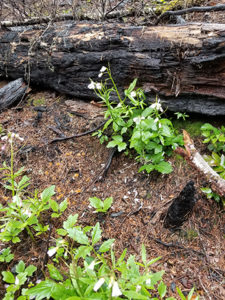It has been a year since the Silver Creek Fire burned approximately 30 acres of forest near Camp Silver Creek, in Silver Falls State Park. Presumably ignited by lightning – the sparks of which smoldered for some time before dry, hot weather caused it to spread – smoke from the fire was first reported on July 12, 2018.
“The fire killed most of the understory plants, saplings and shrubs as well as many of the larger western hemlock trees,” Kevin McLain, a park ranger at Silver Falls State Park said. “Although this was not a crown-fire, we know that if the fire completely circles the cambium of a large western hemlock the tree will most likely die, and this is what we see in this case.”
But not all was lost, and already there are several species of plants making a resurgence in the area.
“Regrowth at this point nearly a year after the fire is primarily weeds and ruderal species, with some Oregon grape, salal, flowers, and other types of berries starting to grow,” McClain said. “This is typical and expected in these types of burns in this ecosystem. In a short time seeds from the nearby trees will start to take in this area. It is helpful that the burn was very small and isolated and there is still plenty of nearby seed sources around it to speed the recovery. There is no reason to believe it will not make a full healthy recovery.”
Fires of this type can seem catastrophic, especially so close to historical structures and private homes, but forest fires are actually a normal and healthy part of the forest ecosystem’s cycle.
“[F]ires are immensely important in forest ecology – although the significance and the role of fire is slightly different in different types of forests and in different types of ecosystems,” McLain said. “It creates and maintains entire ecosystems, and scientists have found interesting links between how plant species have co-evolved with fire. Some plants that have a long history with fire actually ‘self-promote’ their own species by encouraging fire. Chemical, physiological, and physical aspects of these plants will promote certain types of fire behavior and fire frequencies which ultimately determine fire’s larger role in that ecosystem, the types of plants and trees that grow there, and the physical structure of that vegetation.”
The Silver Creek Fire should not be looked upon as a destructive event but as a naturally occurring one that may have been long overdue, according to McClain.
“I can say with some confidence that it is likely there has not been a large fire there since the land became a state park in 1933,” he said. “Historic fire-regimes for these types of forest prior to European settlement saw a fire-return interval of around 25-40 years, so not having a large documented fire for close to a century is a significant change.”
And this kind of fire repression can have a detrimental effect on the overall health of the forests, causing increased tree density, canopy closure and overgrowth of the understory’s “ladder fuels,” which actually increases the fire risk.
“It’s not a matter of if it burns, it’s a matter of when and how severe it burns,” McClain said, quoting a professor from Colorado State University’s Natural Resource Stewardship program, where he is working toward his master’s degree.
“Fire suppression ultimately just postpones the inevitable and allows vegetation to grow in thicker and denser, resulting in more severe, higher-intensity wildfires that are more destructive and take the ecosystem longer to recover from – if they are able to recover at all. Higher-severity fires are a greater threat to human life and they threaten the ecosystem services that forests provide.”
What McClain suggests instead is a pattern of prescribed burns, which help mitigate some of the risk of fires while still promoting biodiversity and preserving naturally occurring plants and animals. But with today’s human population ever-expanding, even the most remote wild spaces and carefully controlled burning requires real planning.
“One solution that National Forests use is to categorize the forest into three different zones depending on how close it comes to people or structures, and then to manage each of those zones differently as it relates to fire,” McClain said.
“In zone one, closest to people and property, all fires are suppressed and only manual fire mitigation is performed through thinning. In zone two prescribed burns are applied. In zone three, the furthest from people, prescribed burns are applied, and naturally-ignited fires are allowed to burn under controlled conditions. This specialized approach can help mitigate some of the risk to people and property, can allow as much natural fire to burn as possible, and is one of the most financially viable options out there.”
But although controlled burning, on a human timeline is possible, it is not yet something that Silver Falls State Park is looking at utilizing any time soon, according to McClain who said,
“[W]ith the current density of Silver Falls’ forests we have to be very careful with what fires we allow to burn and when we allow them to burn as conditions exist right now. If prescribed fires were to be introduced, it is likely that manual thinning would need to be performed first before they can be lit safely, and even then it would likely be lit in a controlled environment with firefighters on scene.”
What McClain is certain of, however, is the importance of fire suppression on a visitor level, where unattended or illegal campfires and discarded cigarettes can be a real risk.
“Please be very careful when recreating in the park to not contribute to the fire-risk by being careless or negligent and accidentally igniting a fire that would jeopardize the future of the park,” he urged. “It is likely that there will be a mandatory fire ban this summer, so it is important to be aware of what is allowed in the park before arriving.”
